Leonardo da Vinci's Leda with Swan Mystical Knowledge
Mesopotamia Gods and their Ancient Wisdom Art, Education, Symbols and Signs, Spirituality, Power of Mind, default, Healthy Living, meditationAncient Worlds Teachings from Leonardo da Vinci's art- Leda with Swan
by Nataša Pantović
During 1505-1510, in Florence, Leonardo da Vinci paints his Leda with the Swan, with the motif of a natural landscape untouched by a human hand, depicting Leda and her lover, the Swan, Zeus disguised, the father of the gods.
I was surprised to see the same Leda in Leonardo’s Madonna of the Rocks as a mystical metaphor for Mary.
Playing with our subconscious mind and using his art to awaken deep emotions, painting with contrasting colors, this genius indirectly tells us where our attraction comes from, and what is our soul connecting with, why is Light so important for us...
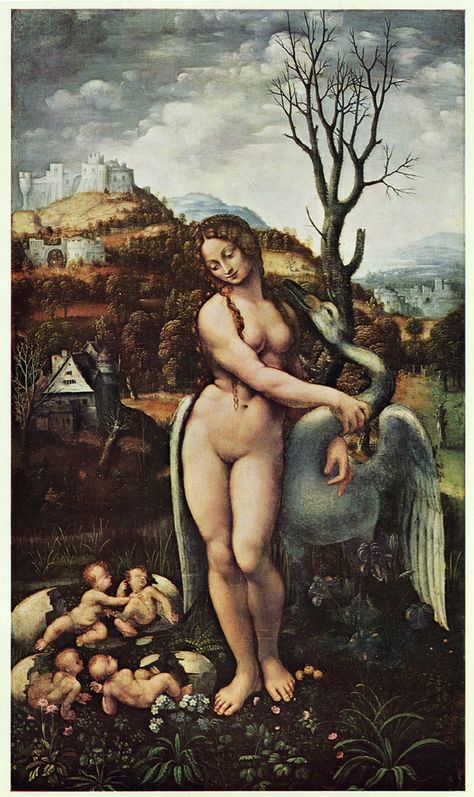
Leda with Swans Leonardo da Vinci 1510
Leda as Venus and our Concept of divine Beauty
Leda has exaggerated curves, as antique statues of Venus had, linking with our subconscious concept of love, a perfect youthful face, with a long pointed nose and no eyebrows, no wrinkles, totally symmetrical, surrounded with gold and sparkles, the body that shines with light, pointing at her children, hatching from eggs.
The original of the painting is lost, probably deliberately destroyed, and was last recorded in the French royal Court in 1625. However the picture is known from many copies, of which the earliest is probably the Spiridon Leda, now in the Uffizi Gallery in Florence.
Madonna of the Rocks by Leonardo
The same Leda was depicted in Leonardo’s symbolism as metaphors for Mary.
A perfect face far too young to be a mother, removed from all the shades of childbirth or motherhood suffering, with the hair-style that you find only in a carefully straightened, with lots of trouble contained curly hair, surely never used in a “staple” condition of Jesus’ birth, with a chubby, happy, content, over-sized baby, awakening “oh, how sweeet” emotional reaction within us, with no “suffering” faces of all ages to remind us that Life is a Struggle.
Madonna and child Jesus with the infant John the Baptist and an angel, in a rocky setting
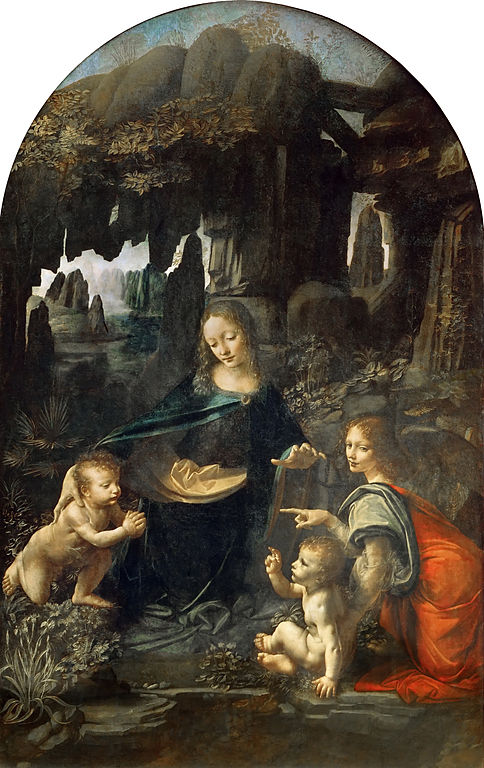
Leonardo Da Vinci Vergine delle Rocce Louvre Paris
This painting is known as Madonna of the Rocks. The earlier version is in The Louvre in Paris and the latter one is in the National Gallery, in London. Both are nearly 2 meters high and painted in oils on wooden panel.
Age of Enlightenment in Venice and Sandro Botticelli’s Venus
Coming from the same city Venice, just a bit earlier (1445 – 1510) we find Sandro Botticelli’s Venus equally entrancing. Some years back, even though this was not my conscious intention, when I visited the Uffizi Gallery in Florence, I just could not get out of the room of where the Botticelli’s Venus was and even though I consciously wished to pay respect to other Masters within the same Gallery, I had to return to silence and divine expansion experienced watching Venus’s adventures.
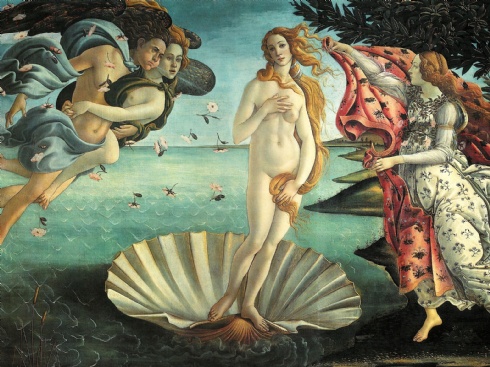
Birth of Venus, Sandro Botticelli 1482, in Uffizi Gallery in Florence
“For primitive man… His country is neither a geographical nor a political entity. It is that territory which contains his mythology, his religion, all his thinking and feeling in so far as he is unconscious of these functions… Primitive man is un-psychological. Psychic happenings take place outside him in an objective way. Even the things he dreams about are real to him…”
Jung, Lecture, Archaic Man, Collected Works, Civilization in Transition
Don’t you find Mythology to be the most fascinating science? Passed through pictures, like the ancient Egyptian spirituality, whether Christians, Muslims or Hindus, Taoist, Jews, Atheists or Buddhists, our scientists, applied psychologists and consciousness researchers, always followed their inner-most drive for goodness as their souls’ quest, no matter what their have chosen as their personal growth system. While in Malta I was graced to meet some of the most inspiring Catholic Priests, father George for example, helped my adoption journey introducing me to Sister’s Luganda’s Ethiopian orphanage, both of them around 60, still following the path of Jesus helping poor within their missions!
Back in the day, by around the 2000 BC to 700 BC, Mesopotamia was ruled by Amorites, the Amorites (/ˈæməˌraɪts/; Sumerian MAR.TU; Egyptian Amar; Hebrew אמורי ʼĔmōrī; Ancient Greek: Ἀμορραῖοι) established Babylon as their largest city. The term Amurru in Sumerian texts refers to both them and to their principal deity. It was the largest city in the world (10 square km), the first city to reach a population above 200,000 people.
Back in the day, their ancient wisdom was passed to us, their ancestors, through pictures on the temples’ walls or vases. So, the whole world of mythological creatures was a gift of conscious and unconscious learnings and some exceptionally talented scientists of the last 200 years devoted their lives to translate these works. When I for the first time held the 16th century book of Plato, in an attempt to closer examine the Old Greeks writingssince it is closer to the way we express our thoughts, I was completely intrigued by the book! It was TINY!!!! Since there was no printing press, his books were just a few A6 pages long.
So when we read “1,000s of Greek boats sailed across the sea to battle a monster…” we call it a myth, a mixture of truth and reality, yet ancient Greeks or Egyptians never drew an image of 1,000 boats, but two indicating “many”, and they drew a monster not necessarily because they believed in monsters but perhaps to warn us against a more advanced enemy that uses fire as weapon, or they encountered a disease sent by Gods – a type of madness perhaps for drinking salty waters, etc... How deeply words get lost in translation! If you wish to explore any subject further, I encourage you my dear consciousness researcher to follow the original research of our ancestors trusting their wisdom inspired logic, going back to the ancient Egyptian paintings and Greek paintings for guideline. Trust me, our brains are no better nor worse than our ancestors’, we just live surrounded by different set of circumstances, and we may or may not use the opportunity to learn from their wisdom inspired knowledge.
Apollo was the God of healing, music and poetry, but also of oracles. Is this a message to use poetry, and music while talking to Gods?
Hermes was the God of travelers and thieves and he played lyre, a bit like our Gypsis…
Mystical Christianity Alpha and Omega
Mesopotamia Gods and their Ancient Wisdom
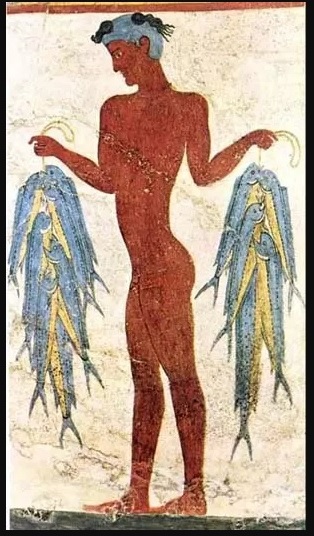
Ancient Greece Fisherman Fresco Akrotiri Mesopotamia 2000 BC
The name 'Europe’ comes from Greek εὖ eu meaning "good" and has been known to our ancients for 1,000s of years. In a Greek myth, God Zeus falls in love with Europa and kidnap her from her family back in Phonecia. Phonecias of the Mediterranean were rulers of the African lands from as early as 4,000 BC. Babylon Mysticism, Neolithic Wisdom, Ancient Greece
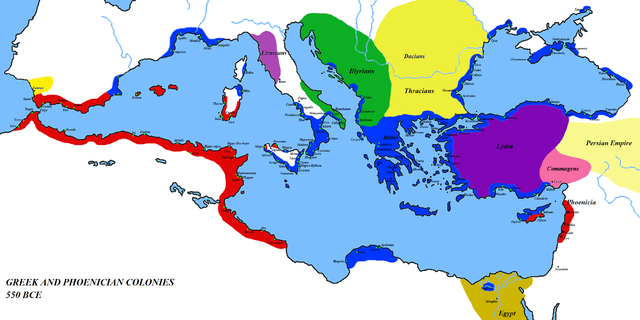
The Mediterranean in 6th century BC Phoenician settlements are labelled in red Greek areas in blue
2,000 BC Cultures of Ethiopia, India, China and Neolithic Wisdom
By the year 4300 BC megalithic tombs were in use all around Mediterranean. Egypt had its pyramids and Malta had its most amazing Temples, various cultures flourished in Ethiopia, India and Egypt. In ancient China, Confucius and Lao Tzu were exploring music and the individual and humanity’s relationship with Tao.
Back in the day, by around the 2000 BC to 700 BC, Mesopotamia was ruled by Amorites, the Amorites (/ˈæməˌraɪts/; Sumerian MAR.TU; Egyptian Amar; Hebrew אמורי ʼĔmōrī; Ancient Greek: Ἀμορραῖοι) established Babylon as their largest city. The term Amurru in Sumerian texts refers to both them and to their principal deity. It was the largest city in the world (10 square km), the first city to reach a population above 200,000 people.
According to Ancient Greece Zeus had many kids, Gods that have protected various cities of Mesopotamia:
Hephaistos, landed on the island of Lemnos, now Italy, becoming a master of fire, metallurgy, and crafts, a blacksmith building houses, armor, and ingenious devices. His workshop was on the Mt. Etna that erupted in Sicily so it allowed the development of metallurgy.
Athena his most favored daughter, is a founder Goddess of the Greek city of Athens with its first public schools, art centers, etc.
The Zeus myths are historical realities of Phoenician, read: North African – Mediterranean – Greek and Arab rule in the wider Mediterranean region between the 1200 and 700 BC.
Wisdom of Minoans, 7,000 BC, Ancient Greece
Minos, Rhadamanthys & Sarpedon – are kids with Europa after Zeus took her to Crete. Minoan Crete goes back to at least 7,000 BC with their legends, architecture and artworks. The Aegean Sea is the home of over 2,000 islands that in the past acted as the ancient Greeks city-states, the largest among them being Crete (Kriti) and Santorini (Thera or Thira).
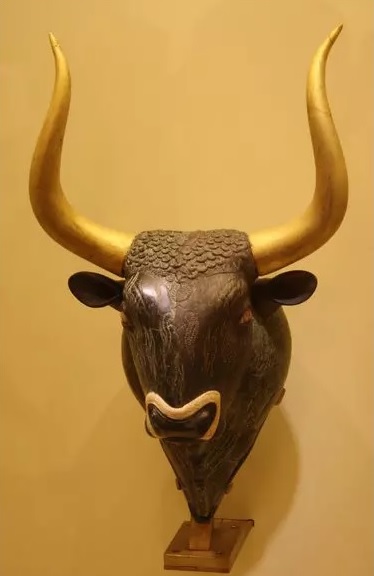
The Minoans were famous for its culture around 2000 BC, and they were a sophisticated political and trading force within Ancient Mediterranean Europe / North Africa. The archeological findings now suggest that their grand buildings were two stories high, decorated with fine frescoes, large courts, staircases, religious offerings, city-wells, drainage systems, extensive storage magazines to store wine, oil, grain, precious metals, and ceramics, and even 'theatre' areas for public spectacles. These all were centrally administrated by their Governors. The lack of fortification walls suggests that they used travelling to trade not to war against other countries. Within the Minoan religion they worshiped bulls, does this sound familiar? The eruption of the volcano on the island of Thera (today Santorini) in 1650 BC, and the resulting tsunami, is acknowledged as the final cause for the fall of the Minoans.
Plato about Atlantis Was Punt Malta?
Plato has described the destruction of Atlantis in his dialogues of the Critias and Timaeus. In his Euthyphro, for example, Plato has the young man who claims to know everything come from the island of Naxos that was wealthy at the time. According to the Greek historian Herodotus, Naxos was the most prosperous in trade 500 BC and was paying tribute to Athens in gold rather than soldiers. The Greeks recorded our history, through mythology, depicting it within their art, because there was no other way to tell the story. Plato's own most profound philosophical influences are Socrates and Pythagoras.
- Philosophy Mother of all Sciences Applied
Applying Quantum Physics Consciousness within the worlds of Philosophy Conscious Living by Nuit In our search for God or Good-ness, consciousness , enlightenment , Bliss,
Zeus was also regarded as the founder of Macedonians, the Ancient Greek tribe that had Alexander the Great as their King. We have heard of him, going to Egypt with Aristotle, in a wish to set up Babylon as his Capital city.
In about 0 BC the Egyptian civilization, the Mycenaean, the Greeks, Macedonians, the Phoenicians (citizens of Canaanites – citizens of Cane), collapsed conquered by the Sea People.
Early Mythology about Chaos and Democracy
- Ancient Temples & Fire Stolen from Gods
Ancient Temples wisdom and Enlightened consciousness by Nataša Pantović Full moon on the Southern Gaia’s Hemisphere came expectedly yet surprisingly different. She met Him - New Consciousness and Group Dynamics
New consciousness & Subconsciousness of Group Dynamics Learning from Prometheus and Titans by Nataša Pantović The subconscious material or mind chitta has its own “body” t
An early myth relates how, in the beginning, there was nothing but chaos in the form of unending waters. We often relate to our own chaos becoming order as a recent adventure of our Race or Culture, ignoring the progress that our ancestors have made. It is tempting to relate to prosperity as a single man’s, or King’s journey, leaving other people’s troubles aside as though we do not live on the same planet and cause each other happiness.
The goddess Eurynome separated the water from the air and began her dance of creation with the serpent Ophion. The gods interacted regularly with the humans who worshipped them as their supporters. As early as 800 BC the Humanity had Republics instead of Monarchies and in Athens, we had Democratic rulers. Organized as a single city-state or polis, we had law as an institution and had regular art and sports festivals, including Olympics. The death of Alexander the Great came around 300 BC, and Pericles started building the Acropolis, we had Plato, Pythagoras, Aristotle, Homer. Democracy meaning Demos = people and Kratos = power, was established in Athens allowing all male citizens over the age of twenty a voice in government. Men like Pythagoras further established mathematics as a serious discipline. Socrates, explored subjects of God, consciousness, Perfection and art flourished.
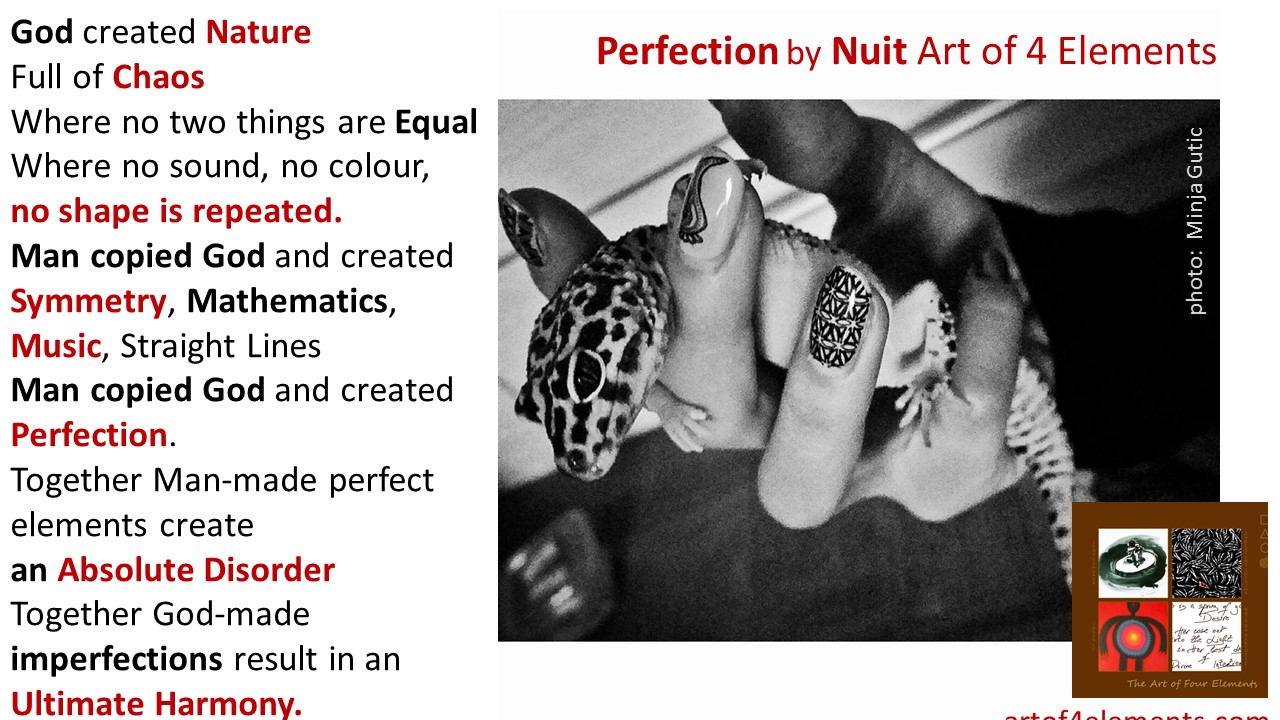
Perfection by Nuit Esoteric Teachings of Golden citizens of Ancient Greece
Check also: Yin Yang Balance within Human Beings
Applying the Laws of Quantum Physics to Philosophy we acknowledge that Micro Cosmos is deeply connected to Macro Cosmos..
- Wisdom of Gods
Ancient Mediterranean Cultures and Advanced Civilizations by Nataša Pantović Nuit The Tao of Logos During the past 50 / 100 years , more and more archeological findings f - El Ra Ma
Supreme God and Sound Frequency Chanting Mantras by Nataša Pantović Nuit The philosophical research concerning the divine and consciousness poses the question: Is there a - The Tao of Logos
by Nataša Pantović Nuit Have you seen the oldest preserved Gospel of John found in Egypt 200 AC? It took me ages but I did go line by line comparing the old Greek text to - Metaphysics of sound
True Name of god and Ancient symbols and frequencies by Nataša Pantović Pulsation, vibration, rhythm exists everywhere as Akasha / Sound / Waves and we hope to reach th






Leonardo da Vinci's Leda with Swan Mystical Knowledge No comments on Leonardo da Vinci's Leda with Swan Mystical Knowledge: